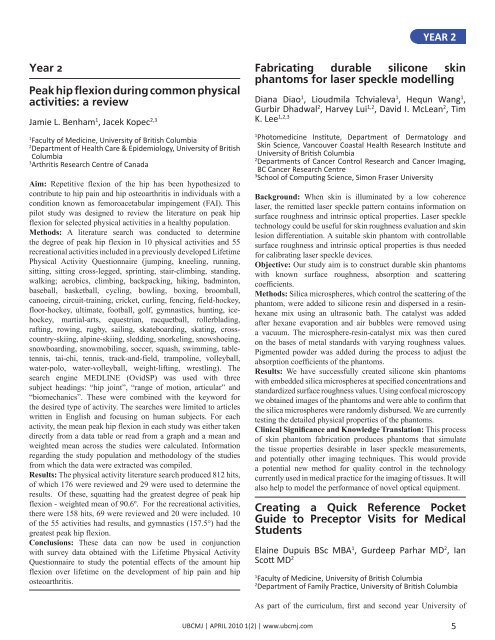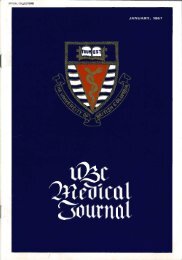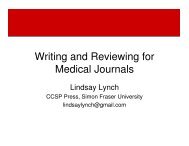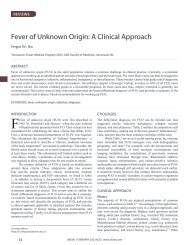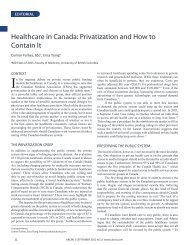Download full PDF - UBC Medical Journal
Download full PDF - UBC Medical Journal
Download full PDF - UBC Medical Journal
You also want an ePaper? Increase the reach of your titles
YUMPU automatically turns print PDFs into web optimized ePapers that Google loves.
YEAR 2<br />
Year 2<br />
Peak hip flexion during common physical<br />
activities: a review<br />
Jamie L. Benham 1 , Jacek Kopec 2,3<br />
1<br />
Faculty of Medicine, University of British Columbia<br />
2<br />
Department of Health Care & Epidemiology, University of British<br />
Columbia<br />
3<br />
Arthritis Research Centre of Canada<br />
Aim: Repetitive flexion of the hip has been hypothesized to<br />
contribute to hip pain and hip osteoarthritis in individuals with a<br />
condition known as femoroacetabular impingement (FAI). This<br />
pilot study was designed to review the literature on peak hip<br />
flexion for selected physical activities in a healthy population.<br />
Methods: A literature search was conducted to determine<br />
the degree of peak hip flexion in 10 physical activities and 55<br />
recreational activities included in a previously developed Lifetime<br />
Physical Activity Questionnaire (jumping, kneeling, running,<br />
sitting, sitting cross-legged, sprinting, stair-climbing, standing,<br />
walking; aerobics, climbing, backpacking, hiking, badminton,<br />
baseball, basketball, cycling, bowling, boxing, broomball,<br />
canoeing, circuit-training, cricket, curling, fencing, field-hockey,<br />
floor-hockey, ultimate, football, golf, gymnastics, hunting, icehockey,<br />
martial-arts, equestrian, racquetball, rollerblading,<br />
rafting, rowing, rugby, sailing, skateboarding, skating, crosscountry-skiing,<br />
alpine-skiing, sledding, snorkeling, snowshoeing,<br />
snowboarding, snowmobiling, soccer, squash, swimming, tabletennis,<br />
tai-chi, tennis, track-and-field, trampoline, volleyball,<br />
water-polo, water-volleyball, weight-lifting, wrestling). The<br />
search engine MEDLINE (OvidSP) was used with three<br />
subject headings: “hip joint”, “range of motion, articular” and<br />
“biomechanics”. These were combined with the keyword for<br />
the desired type of activity. The searches were limited to articles<br />
written in English and focusing on human subjects. For each<br />
activity, the mean peak hip flexion in each study was either taken<br />
directly from a data table or read from a graph and a mean and<br />
weighted mean across the studies were calculated. Information<br />
regarding the study population and methodology of the studies<br />
from which the data were extracted was compiled.<br />
Results: The physical activity literature search produced 812 hits,<br />
of which 176 were reviewed and 29 were used to determine the<br />
results. Of these, squatting had the greatest degree of peak hip<br />
flexion - weighted mean of 90.6º. For the recreational activities,<br />
there were 158 hits, 69 were reviewed and 20 were included. 10<br />
of the 55 activities had results, and gymnastics (157.5°) had the<br />
greatest peak hip flexion.<br />
Conclusions: These data can now be used in conjunction<br />
with survey data obtained with the Lifetime Physical Activity<br />
Questionnaire to study the potential effects of the amount hip<br />
flexion over lifetime on the development of hip pain and hip<br />
osteoarthritis.<br />
Fabricating durable silicone skin<br />
phantoms for laser speckle modelling<br />
Diana Diao 1 , Lioudmila Tchvialeva 1 , Hequn Wang 1 ,<br />
Gurbir Dhadwal 2 , Harvey Lui 1,2 , David I. McLean 2 , Tim<br />
K. Lee 1,2,3<br />
1<br />
Photomedicine Institute, Department of Dermatology and<br />
Skin Science, Vancouver Coastal Health Research Institute and<br />
University of British Columbia<br />
2<br />
Departments of Cancer Control Research and Cancer Imaging,<br />
BC Cancer Research Centre<br />
3<br />
School of Computing Science, Simon Fraser University<br />
Background: When skin is illuminated by a low coherence<br />
laser, the remitted laser speckle pattern contains information on<br />
surface roughness and intrinsic optical properties. Laser speckle<br />
technology could be useful for skin roughness evaluation and skin<br />
lesion differentiation. A suitable skin phantom with controllable<br />
surface roughness and intrinsic optical properties is thus needed<br />
for calibrating laser speckle devices.<br />
Objective: Our study aim is to construct durable skin phantoms<br />
with known surface roughness, absorption and scattering<br />
coefficients.<br />
Methods: Silica microspheres, which control the scattering of the<br />
phantom, were added to silicone resin and dispersed in a resinhexane<br />
mix using an ultrasonic bath. The catalyst was added<br />
after hexane evaporation and air bubbles were removed using<br />
a vacuum. The microsphere-resin-catalyst mix was then cured<br />
on the bases of metal standards with varying roughness values.<br />
Pigmented powder was added during the process to adjust the<br />
absorption coefficients of the phantoms.<br />
Results: We have success<strong>full</strong>y created silicone skin phantoms<br />
with embedded silica microspheres at specified concentrations and<br />
standardized surface roughness values. Using confocal microscopy<br />
we obtained images of the phantoms and were able to confirm that<br />
the silica microspheres were randomly disbursed. We are currently<br />
testing the detailed physical properties of the phantoms.<br />
Clinical Significance and Knowledge Translation: This process<br />
of skin phantom fabrication produces phantoms that simulate<br />
the tissue properties desirable in laser speckle measurements,<br />
and potentially other imaging techniques. This would provide<br />
a potential new method for quality control in the technology<br />
currently used in medical practice for the imaging of tissues. It will<br />
also help to model the performance of novel optical equipment.<br />
Creating a Quick Reference Pocket<br />
Guide to Preceptor Visits for <strong>Medical</strong><br />
Students<br />
Elaine Dupuis BSc MBA 1 , Gurdeep Parhar MD 2 , Ian<br />
Scott MD 2<br />
1<br />
Faculty of Medicine, University of British Columbia<br />
2<br />
Department of Family Practice, University of British Columbia<br />
As part of the curriculum, first and second year University of<br />
<strong>UBC</strong>MJ | APRIL 2010 1(2) | www.ubcmj.com 5


